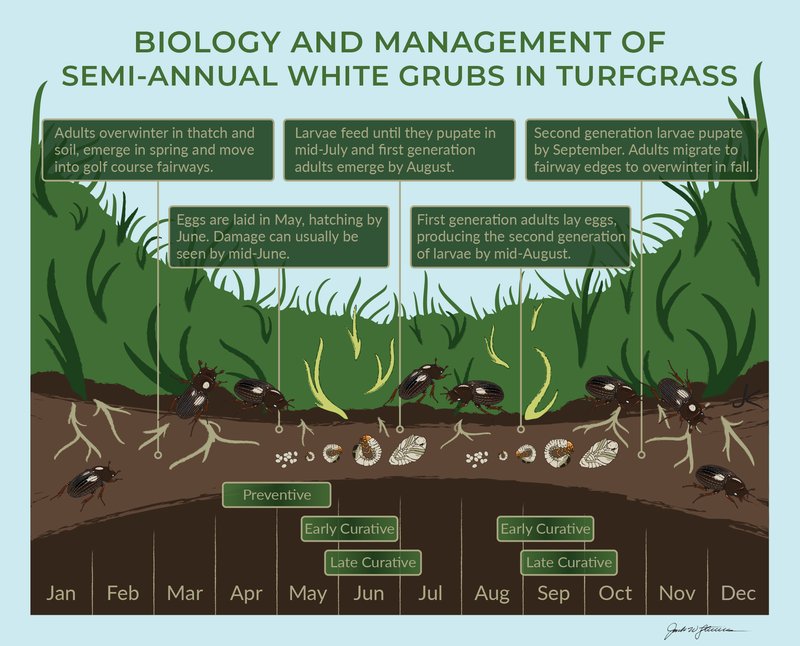
Grub worms, mainly the larvae of beetles like Japanese beetles and June bugs, are common culprits when it comes to damaging grass. Imagine having a party at your home only to find uninvited guests tearing down your carefully arranged decorations. That’s what grubs can do to your turfgrass roots. They munch on roots, starving the grass of nutrients and water, which can lead to dead patches and an unhealthy lawn. So, let’s dig a little deeper and see just how grubs affect your turfgrass root systems and what you can do to keep your lawn thriving.
What Are Grub Worms?
Grub worms are the larvae of various types of beetles. They typically have a C-shape, white coloring, and can vary in size depending on their species and stage of life. You might be wondering how they even get into your yard. Well, adult beetles lay their eggs in your lawn during warm months, usually late spring to early summer. Once the eggs hatch, the baby grubs start feasting on the roots of your grass—yikes!
These little guys go through a life cycle that can span several months. They primarily feed during the late summer and early fall, which is when their damage to your turfgrass is often most evident. Homeowners often notice signs of grub infestation when they see brown patches, wilting grass, or sections of sod that can be easily peeled back like a carpet. That’s a sure sign that grubs are at work underground.
How Grub Worms Damage Turfgrass Roots
The main way grub worms affect turfgrass roots is by consuming them. Turfgrass roots are essential for the health of your lawn because they absorb nutrients and water. When grubs get in the mix, they gnaw on these roots, disrupting this vital process. Think of roots as the foundation of your grass; without a strong base, the grass can’t grow tall and healthy.
In severe cases, the damage can lead to significant turf loss. You may start to see areas where the grass turns brown and becomes crispy. This happens because the grass is stripped of the necessary nutrients and moisture, much like a plant without water or sunlight. If left untreated, an area of grass that seems small can quickly spread, leading to larger patches of dead turf.
Recognizing the Signs of Grub Infestation
So, how can you tell if you have a grub worm problem? Here are some signs to look out for:
- Browning Grass: Areas that appear brown, particularly in the summer, indicate issues.
- Soft or Spongy Soil: If your grass feels spongy and easily pulls up, grubs might be beneath the surface.
- Pest Sightings: Spotting adult beetles flying around your yard can be a warning sign.
- Bird Activity: Increased activity from birds that are pecking at your lawn indicates they’re searching for grubs to munch on.
Recognizing these signs early can save you a lot of headaches down the road. If you’re seeing one or more of these indicators, it might be time to investigate further.
How to Test for Grub Worms
If you suspect grub worms are the culprits harming your grass, it’s easy to confirm. Here’s how you can test your lawn:
1. **Choose an infested area:** Identify a patch of grass showing signs of damage.
2. **Dig a small section of turf:** Grab a shovel and dig a square foot of sod about 3 inches deep.
3. **Inspect the soil:** Look for the presence of grubs in the soil. You should see them wriggling around if they’re present.
If you find more than a few grubs per square foot, it’s a signal that treatment is necessary. Don’t worry—there are solutions to help tackle this issue.
Treating Grub Infestations
There are multiple methods to deal with grub worms, ranging from natural solutions to chemical treatments. Here are some options:
- Nematodes: These tiny worms attack grubs and are a natural, eco-friendly option. They can be introduced to the soil and will help control the grub population.
- Milky Spore: Another natural treatment that targets Japanese beetles, this substance can be applied to the soil to help curtail future infestations.
- Insecticides: There are a variety of chemical treatments available. Look for products labeled specifically for grub control, and follow the manufacturer’s instructions closely.
Each treatment has its pros and cons, so it’s wise to consider what fits your lawn care philosophy. Make sure you read product labels to ensure you’re using them safely and effectively.
Preventing Grub Worms from Returning
Once you’ve tackled your grub problem, the next step is prevention. Here’s how you can stop them from coming back:
- Maintain Healthy Grass: Healthy, thick grass is less likely to attract beetles, which will lay eggs leading to grubs.
- Water Wisely: Proper watering techniques can encourage deep root growth, making your grass more resilient against infestations.
- Regular Lawn Care: Aerating your lawn and applying organic fertilizers can help promote healthy soil and grass.
By implementing these practices, you create an unwelcoming environment for grubs and keep your lawn looking its best.
Understanding how grub worms affect turfgrass root systems is crucial for any homeowner looking to maintain a healthy lawn. These little creatures may seem harmless at first, but they can wreak havoc if left unchecked. By recognizing the signs of infestation, testing for grubs, and applying the right treatments, you can protect your lawn from their destructive tendencies. Remember, a proactive approach goes a long way, so prioritize lawn care and preventive measures. With time and attention, your lawn can thrive, free from the grasp of these pesky grub worms.

